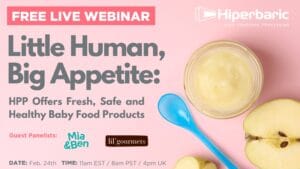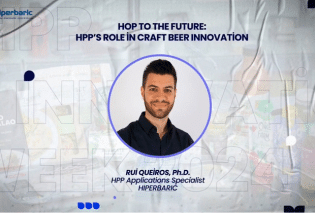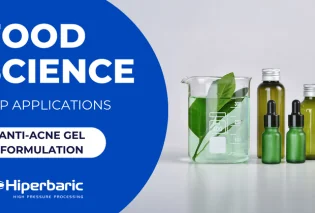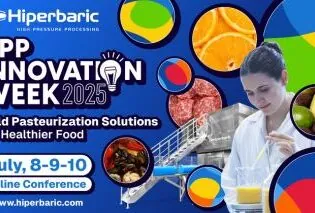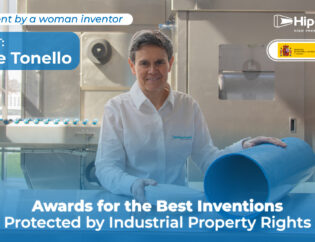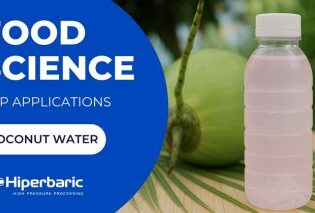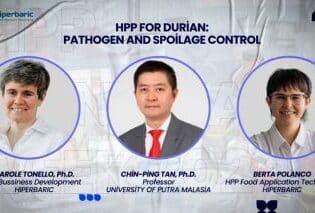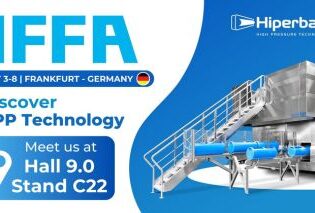

Developing baby food products represents a challenge from safety and quality perspectives. The lack of the time to daily prepare homemade baby food is pushing parents to acquire convenient ready-to-eat (RTE) formulas. High-pressure processing (HPP) allows developing tasty and nourishing formulas just like those freshly made at home. Consequently, the number of HPP baby food products is increasingly growing with more and more companies placing a variety of new products in the market.
The way your baby is introduced to solid food intake is anything but a trivial decision. An appropriate selection of ingredients and cooking methods are crucial for the proper development of the baby. Still, due to the frenzied rhythm of the modern lifestyle, parents lack the time to daily prepare homemade food. Existing shelf-stable commercial preparations become a solution although flavor, appearance and nutritional qualities are greatly affected by the severe heat that is typically applied to ensure microbiological stability and safety.
Fortunately, High-Pressure Processing (HPP) allows developing minimally processed refrigerated infant products that are safe and with a long shelf-life. Quality is enhanced without compromising nutritional, functional, sensory, and convenience characteristics of baby food preparations. This aligns with research suggesting that feeding infants with home-cooked fruit and vegetable meals is associated with a more varied diet in subsequent years (Maslin et al. 2015). Apparently, taste buds get accustomed to the taste of real food rather than ultra-processed formulas.
Increasing awareness regarding the negative effects of ultra-processed food consumption on human health makes HPP an attractive alternative to provide infants with plenty of nutrients and with the real taste of fresh ingredients.
How sensory quality is maintained
Heat sterilization or retorting destroys all forms of microorganisms and allows the commercialization of shelf-stable baby food preparations. However, many nutrients such as vitamins or amino acids are heat sensitive and see their bioavailability reduced. Chemical reactions induced by heat lead to color changes and flavor alterations (Figure 1). On the other hand, HPP does not induce the formation of new compounds or the breakage of covalent bonds. Hence, the structure and functionality of nutrients and flavor compounds remain intact at the same time that microorganisms are effectively inactivated due to alterations in their organelles.
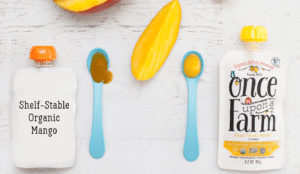
Research suggests that HPP minimally affects sensory attributes of color, taste, aroma, consistency and overall quality in strawberry puree. A group of trained panelists did not identify significant differences between fresh and high-pressure processed (500 MPa/72,500 psi for 15 min) purees (Marszałek et al. 2015; Figure 2A). Similarly, the characteristic green color of spinach puree was retained after processing at 600 MPa/87,000 psi for 25 min as evidenced by non-significant changes in the –a* color coordinate descriptor (Wang et al. 2012). This is reflected in the concentration of chlorophylls “a” and “b”, which remained stable after HPP but suffered a significant decrease after thermal processing (100 °C/212 °F for 1 min) (Figure 2B).
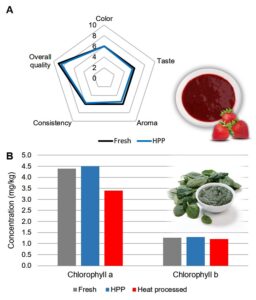
More specifically, instrumental characterization of volatile compounds of kiwifruit and multiple berries purees processed at 600 MPa/87,000 psi for 3 and 5 min, respectively, concluded that the quality of HPP purees was clearly closer to fresh samples compared to their heat processed counterparts (80–85 °C/176–185 °F for 5 min) (Dalmadi et al. 2007; Yi et al. 2016).
HPP ensures retention of functionality
It is important to educate the palate of young children to the taste of fresh food; but it is not less important to ensure an adequate intake of functional compounds. Whereas heat preservation methods destroy some of these bioactive molecules, HPP maintains them stable and functional.
Tomato and carrot are two of the most common vegetable ingredients used as a base for the preparation of baby food. Researchers demonstrated that even intense HPP conditions (600 MPa/87,000 psi for 15 min) retain a higher concentration of total phenols and carotenoids than traditional thermal processing (70 °C/158 °F for 2 min) (Patras et al. 2009; Figure 3).
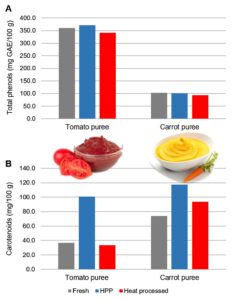
Similarly, vitamin C and total anthocyanins from strawberry puree are less affected by HPP (500 MPa/72,500 psi for 15 min) than by heat processing (90 °C/194 °F for 15 min) (Marszałek et al. 2015; Figure 4). It is frequently reported that the concentration of bioactive compounds not only does not decrease after HPP, but increases. This can be attributed to HPP-induced vegetable cell membrane disruption, which promotes the release of molecules from the cytoplasm and makes them more accessible. Examples include avocado, nectarine and pumpkin purees where the concentration of carotenes increased a 126%, 66% and 36% after HPP (600 MPa/87,000 psi for 3–5 min) compared to unprocessed samples (Jacobo-Velázquez et al. 2012; García-Parra et al. 2014; Contador et al. 2014).
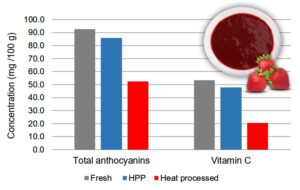
Premium quality with a longer shelf life
The major advantage of HPP lies in the fact that in addition to higher quality, it also results in safe products with longer shelf lives. The control of microbiological spoilage indicators (such as molds, yeasts or total aerobic bacteria) creates stable formulas during refrigerated storage. A representative example is avocado puree, where reductions of up to 5 log CFU/g of mesophilic and lactic acid bacteria could be observed for 45 days after processing at 600 MPa/87,000 psi for 3 min (Jacobo-Velázquez et al. 2010; Figure 5).
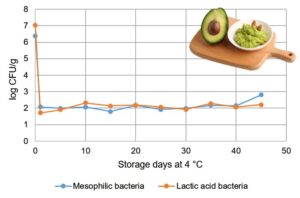
Commercially available RTE baby food preparations need to comply with very strict microbiological criteria. Interestingly, HPP can effectively control pathogens such as Listeria monocytogenes or Salmonella spp. Subjecting cantaloupe puree at 500 MPa/72,500 psi for 5 min achieved a >5-log reduction both pathogens (Mukhopadhyay et al. 2016). Similarly, processing strawberry puree at 450 MPa/65,300 psi for 5 min caused a 6.8-log reduction of Escherichia coli O157:H7 (Huang et al. 2013). In addition to bacterial pathogens, research also evidences that HPP (600 MPa/87,000 psi for 2 min) can control viruses (such as human norovirus) in strawberry puree (DiCaprio et al. 2019).
If you want to know more about the benefits that HPP can provide to your baby food products, register now in the webinar we are organizing on February, 24. Our gest panelist will be Mia & Ben and lil’ gourmets, two successful HPP baby food brands based in the UK and the US. Register now for free!


